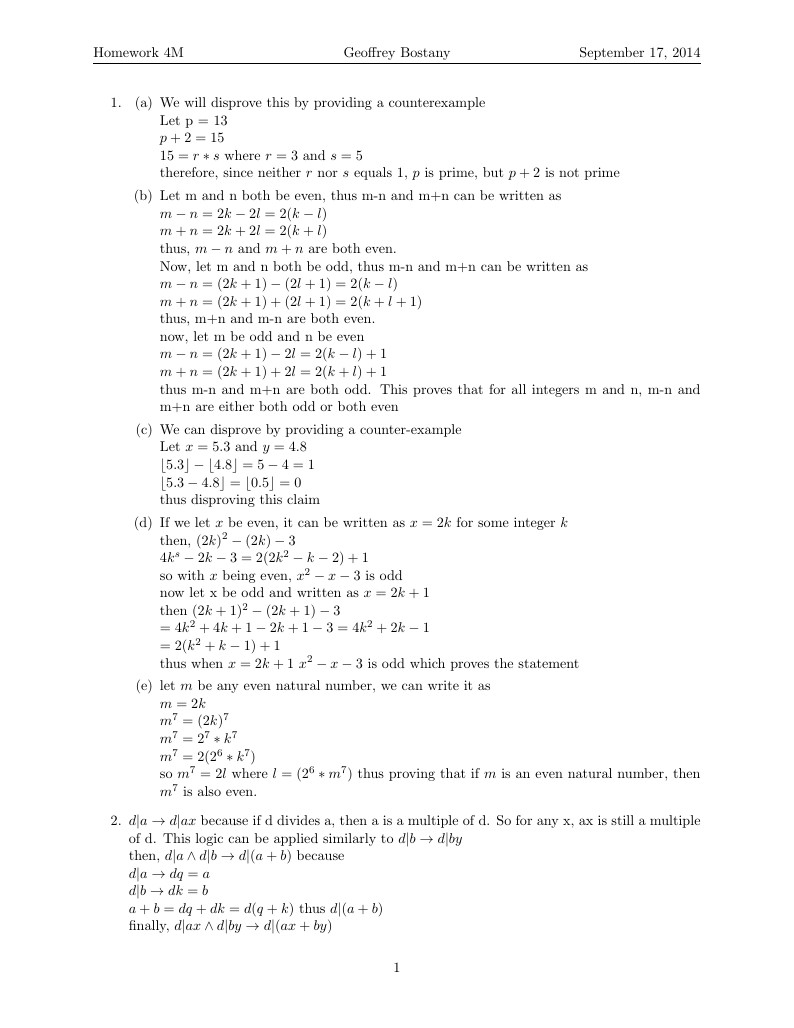
Homework 4m
Author:
Geoffrey Bostany
Last Updated:
11 yıl önce
License:
Creative Commons CC BY 4.0
Abstract:
homework 4m

\begin
Discover why over 20 million people worldwide trust Overleaf with their work.

\begin
Discover why over 20 million people worldwide trust Overleaf with their work.
\documentclass[11pt]{article}
\usepackage[margin=1in]{geometry}
\usepackage{fancyhdr}
\usepackage{amssymb}
\pagestyle{fancy}
\lhead{Homework 4M}
\chead{Geoffrey Bostany}
\rhead{September 17, 2014}
\begin{document}
\begin{enumerate}
\item
\begin{enumerate}
\item We will disprove this by providing a counterexample \\ Let p = 13 \\ $p+2=15$ \\ $15=r*s$ where $r=3$ and $s=5$ \\ therefore, since neither $r$ nor $s$ equals 1, $p$ is prime, but $p+2$ is not prime
\item Let m and n both be even, thus m-n and m+n can be written as \\ $m-n=2k-2l=2(k-l)$ \\ $m+n=2k+2l=2(k+l)$ \\ thus, $m-n$ and $m+n$ are both even. \\ Now, let m and n both be odd, thus m-n and m+n can be written as \\ $m-n=(2k+1)-(2l+1)=2(k-l)$ \\ $m+n=(2k+1)+(2l+1)=2(k+l+1)$ \\ thus, m+n and m-n are both even. \\ now, let m be odd and n be even \\ $m-n=(2k+1)-2l=2(k-l)+1$ \\ $m+n=(2k+1)+2l=2(k+l)+1$ \\ thus m-n and m+n are both odd. This proves that for all integers m and n, m-n and m+n are either both odd or both even
\item We can disprove by providing a counter-example \\ Let $x=5.3$ and $y=4.8$ \\ $\lfloor 5.3 \rfloor - \lfloor 4.8 \rfloor = 5-4=1$ \\ $\lfloor 5.3-4.8 \rfloor = \lfloor 0.5 \rfloor = 0$ \\ thus disproving this claim
\item If we let $x$ be even, it can be written as $x=2k$ for some integer $k$ \\ then, $(2k)^2-(2k)-3$ \\ $4k^s-2k-3 = 2(2k^2-k-2)+1$ \\ so with $x$ being even, $x^2-x-3$ is odd \\ now let x be odd and written as $x=2k+1$ \\ then $(2k+1)^2-(2k+1)-3$ \\ $=4k^2+4k+1-2k+1-3 = 4k^2+2k-1 \\ =2(k^2+k-1)+1$ \\ thus when $x=2k+1$ $x^2-x-3$ is odd which proves the statement
\item let $m$ be any even natural number, we can write it as \\ $m=2k$ \\ $m^7=(2k)^7 \\ m^7=2^7*k^7$ \\ $m^7=2(2^6*k^7)$ \\ so $m^7=2l$ where $l=(2^6*m^7)$ thus proving that if $m$ is an even natural number, then $m^7$ is also even.
\end{enumerate}
\item $d|a \to d|ax$ because if d divides a, then a is a multiple of d. So for any x, ax is still a multiple of d. This logic can be applied similarly to $d|b \to d|by$ \\ then, $d|a \wedge d|b \to d|(a+b)$ because \\ $d|a \to dq=a \\ d|b \to dk=b \\ a+b=dq+dk=d(q+k)$ thus $d|(a+b)$\\ finally, $d|ax \wedge d|by \to d|(ax+by)$
\item given $x,y, z$ if $x-y$ is odd, and $y-z$ is even, then they can be written as: \\ $x-y=2k+1$ for some integer $k$ and $y-z=2l$ for some integer $l$ \\ now, we will isolate $x$ and $z$ to test the proof. \\ $x=2k+y+1$ and $z=-2l+y$ \\ then, $x-z=2k+y+1+2l-y=2(k+l)+1$ thus, $x-z=2n+1$ where $n=(k+1)$ therefore $x-z$ is odd
\item To prove that if $r$ is irrational, then $r^\frac{1}{t}$ is also irrational, we will prove the contrapositive. \\ Start by assuming that $r^\frac{1}{t}$ is rational so $r^\frac{1}{t}=z$ such that $z \in \mathbb{Q}$ \\ since $z \in \mathbb{Q}$, $z=\frac{a}{b}$ such that $b \neq 0$ and $a,b \in\mathbb{Z}$ \\ $r^\frac{1}{t}=z$ \\ $(r^\frac{1}{t})^t=z^t=r$ \\ $r=(\frac{a}{b})^t=\frac{a^t}{b^t}$ where $t>0$ \\ thus $b^t \neq 0$ and $a^t,b^t \in \mathbb{Z}$ because $a^t$ and $b^t$ are just the product of integers \\ and therefore $r$ is a rational number which proves the contrapositive
\end{enumerate}
\end{document}